warning Lancia Ypsilon 2021 Owner handbook (in English)
[x] Cancel search | Manufacturer: LANCIA, Model Year: 2021, Model line: Ypsilon, Model: Lancia Ypsilon 2021Pages: 200, PDF Size: 4.53 MB
Page 18 of 200
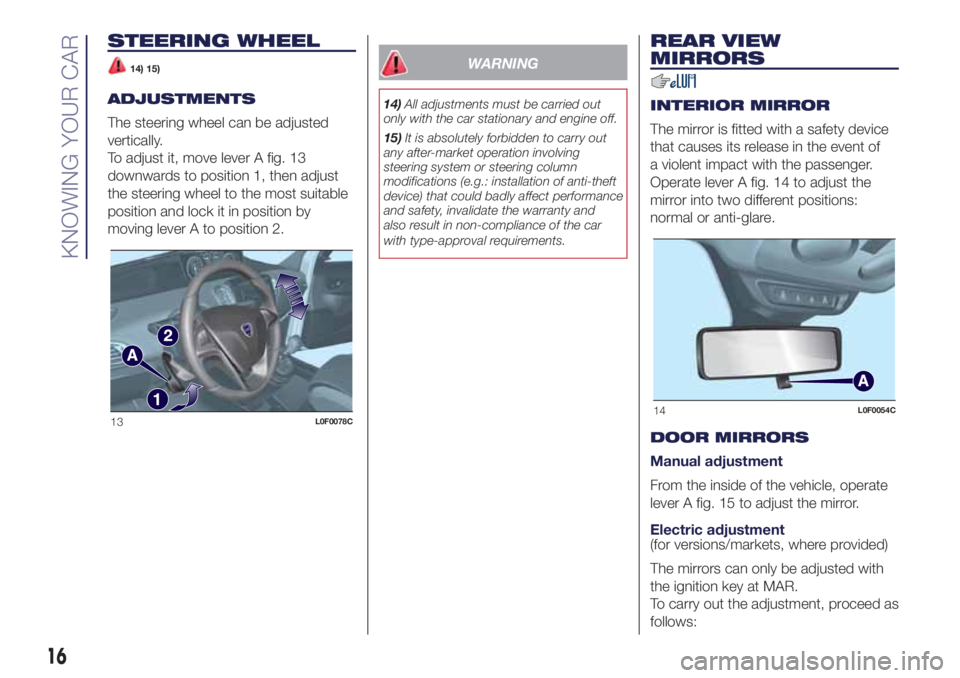
STEERING WHEEL
14) 15)
ADJUSTMENTS
The steering wheel can be adjusted
vertically.
To adjust it, move lever A fig. 13
downwards to position 1, then adjust
the steering wheel to the most suitable
position and lock it in position by
moving lever A to position 2.
WARNING
14)All adjustments must be carried out
only with the car stationary and engine off.
15)It is absolutely forbidden to carry out
any after-market operation involving
steering system or steering column
modifications (e.g.: installation of anti-theft
device) that could badly affect performance
and safety, invalidate the warranty and
also result in non-compliance of the car
with type-approval requirements.
REAR VIEW
MIRRORS
INTERIOR MIRROR
The mirror is fitted with a safety device
that causes its release in the event of
a violent impact with the passenger.
Operate lever A fig. 14 to adjust the
mirror into two different positions:
normal or anti-glare.
DOOR MIRRORS
Manual adjustment
From the inside of the vehicle, operate
lever A fig. 15 to adjust the mirror.
Electric adjustment
(for versions/markets, where provided)
The mirrors can only be adjusted with
the ignition key at MAR.
To carry out the adjustment, proceed as
follows:
13L0F0078C14L0F0054C
16
KNOWING YOUR CAR
Page 20 of 200
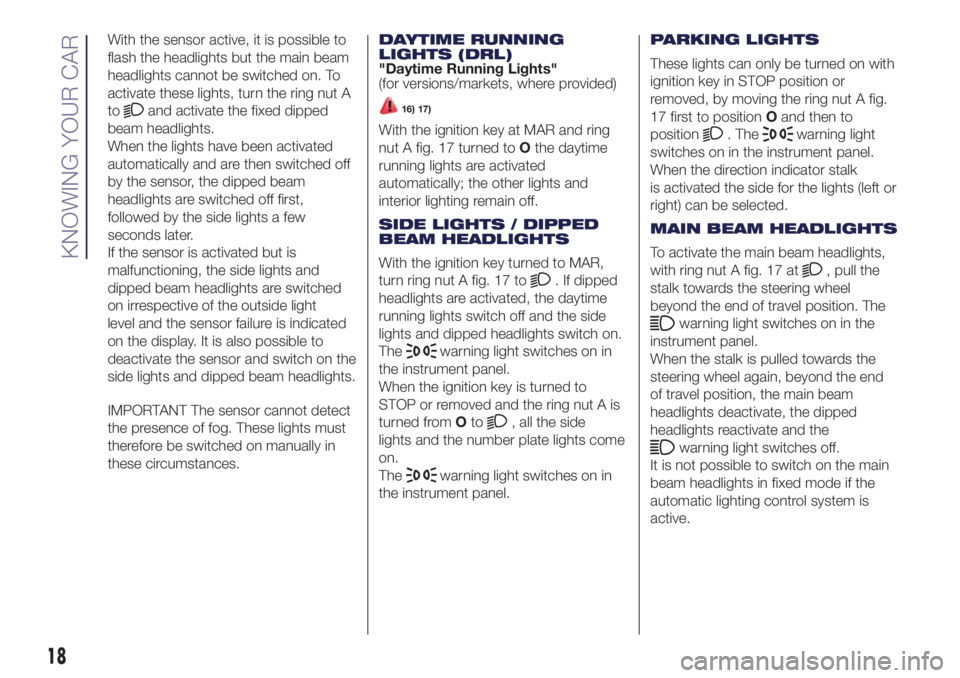
With the sensor active, it is possible to
flash the headlights but the main beam
headlights cannot be switched on. To
activate these lights, turn the ring nut A
to
and activate the fixed dipped
beam headlights.
When the lights have been activated
automatically and are then switched off
by the sensor, the dipped beam
headlights are switched off first,
followed by the side lights a few
seconds later.
If the sensor is activated but is
malfunctioning, the side lights and
dipped beam headlights are switched
on irrespective of the outside light
level and the sensor failure is indicated
on the display. It is also possible to
deactivate the sensor and switch on the
side lights and dipped beam headlights.
IMPORTANT The sensor cannot detect
the presence of fog. These lights must
therefore be switched on manually in
these circumstances.DAYTIME RUNNING
LIGHTS (DRL)
"Daytime Running Lights"
(for versions/markets, where provided)16) 17)
With the ignition key at MAR and ring
nut A fig. 17 turned toOthe daytime
running lights are activated
automatically; the other lights and
interior lighting remain off.
SIDE LIGHTS / DIPPED
BEAM HEADLIGHTS
With the ignition key turned to MAR,
turn ring nut A fig. 17 to
. If dipped
headlights are activated, the daytime
running lights switch off and the side
lights and dipped headlights switch on.
The
warning light switches on in
the instrument panel.
When the ignition key is turned to
STOP or removed and the ring nut A is
turned fromOto
, all the side
lights and the number plate lights come
on.
The
warning light switches on in
the instrument panel.PARKING LIGHTS
These lights can only be turned on with
ignition key in STOP position or
removed, by moving the ring nut A fig.
17 first to positionOand then to
position
. Thewarning light
switches on in the instrument panel.
When the direction indicator stalk
is activated the side for the lights (left or
right) can be selected.
MAIN BEAM HEADLIGHTS
To activate the main beam headlights,
with ring nut A fig. 17 at
, pull the
stalk towards the steering wheel
beyond the end of travel position. The
warning light switches on in the
instrument panel.
When the stalk is pulled towards the
steering wheel again, beyond the end
of travel position, the main beam
headlights deactivate, the dipped
headlights reactivate and the
warning light switches off.
It is not possible to switch on the main
beam headlights in fixed mode if the
automatic lighting control system is
active.
18
KNOWING YOUR CAR
Page 21 of 200
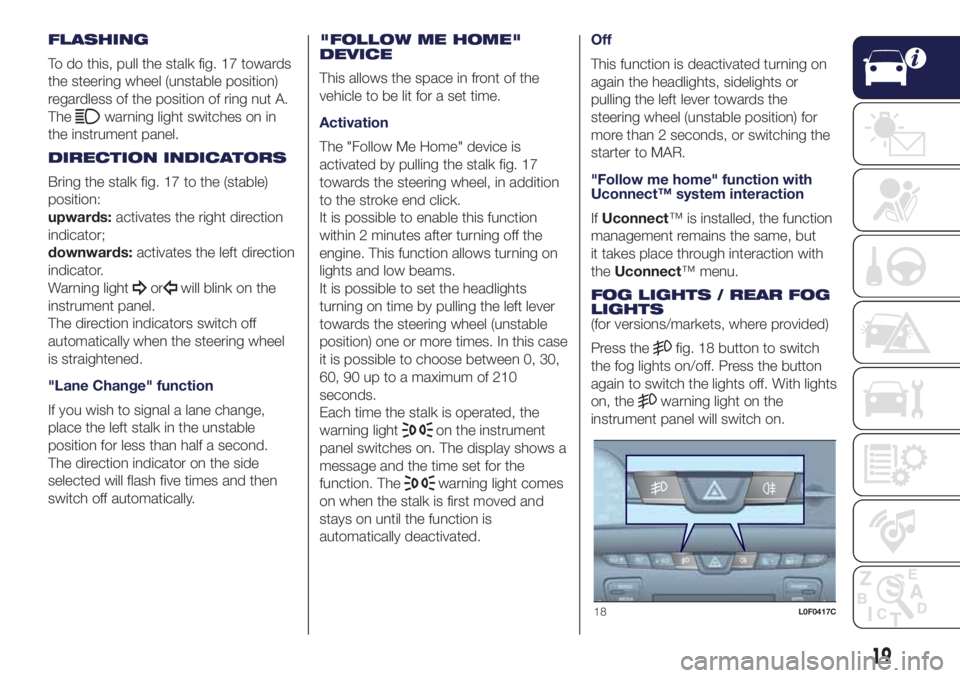
FLASHING
To do this, pull the stalk fig. 17 towards
the steering wheel (unstable position)
regardless of the position of ring nut A.
The
warning light switches on in
the instrument panel.
DIRECTION INDICATORS
Bring the stalk fig. 17 to the (stable)
position:
upwards:activates the right direction
indicator;
downwards:activates the left direction
indicator.
Warning light
orwill blink on the
instrument panel.
The direction indicators switch off
automatically when the steering wheel
is straightened.
"Lane Change" function
If you wish to signal a lane change,
place the left stalk in the unstable
position for less than half a second.
The direction indicator on the side
selected will flash five times and then
switch off automatically."FOLLOW ME HOME"
DEVICE
This allows the space in front of the
vehicle to be lit for a set time.
Activation
The "Follow Me Home" device is
activated by pulling the stalk fig. 17
towards the steering wheel, in addition
to the stroke end click.
It is possible to enable this function
within 2 minutes after turning off the
engine. This function allows turning on
lights and low beams.
It is possible to set the headlights
turning on time by pulling the left lever
towards the steering wheel (unstable
position) one or more times. In this case
it is possible to choose between 0, 30,
60, 90 up to a maximum of 210
seconds.
Each time the stalk is operated, the
warning light
on the instrument
panel switches on. The display shows a
message and the time set for the
function. The
warning light comes
on when the stalk is first moved and
stays on until the function is
automatically deactivated.Off
This function is deactivated turning on
again the headlights, sidelights or
pulling the left lever towards the
steering wheel (unstable position) for
more than 2 seconds, or switching the
starter to MAR.
"Follow me home" function with
Uconnect™ system interaction
IfUconnect™ is installed, the function
management remains the same, but
it takes place through interaction with
theUconnect™ menu.
FOG LIGHTS / REAR FOG
LIGHTS
(for versions/markets, where provided)
Press the
fig. 18 button to switch
the fog lights on/off. Press the button
again to switch the lights off. With lights
on, the
warning light on the
instrument panel will switch on.
18L0F0417C
19
Page 22 of 200
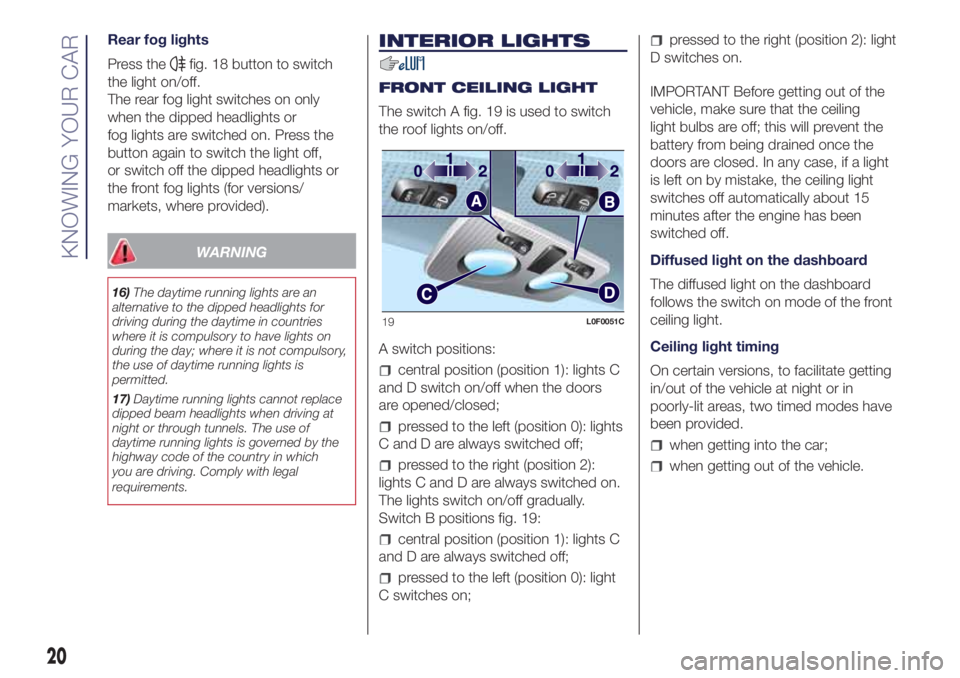
Rear fog lights
Press the
fig. 18 button to switch
the light on/off.
The rear fog light switches on only
when the dipped headlights or
fog lights are switched on. Press the
button again to switch the light off,
or switch off the dipped headlights or
the front fog lights (for versions/
markets, where provided).
WARNING
16)The daytime running lights are an
alternative to the dipped headlights for
driving during the daytime in countries
where it is compulsory to have lights on
during the day; where it is not compulsory,
the use of daytime running lights is
permitted.
17)Daytime running lights cannot replace
dipped beam headlights when driving at
night or through tunnels. The use of
daytime running lights is governed by the
highway code of the country in which
you are driving. Comply with legal
requirements.
INTERIOR LIGHTS
FRONT CEILING LIGHT
The switch A fig. 19 is used to switch
the roof lights on/off.
A switch positions:
central position (position 1): lights C
and D switch on/off when the doors
are opened/closed;
pressed to the left (position 0): lights
C and D are always switched off;
pressed to the right (position 2):
lights C and D are always switched on.
The lights switch on/off gradually.
Switch B positions fig. 19:
central position (position 1): lights C
and D are always switched off;
pressed to the left (position 0): light
C switches on;
pressed to the right (position 2): light
D switches on.
IMPORTANT Before getting out of the
vehicle, make sure that the ceiling
light bulbs are off; this will prevent the
battery from being drained once the
doors are closed. In any case, if a light
is left on by mistake, the ceiling light
switches off automatically about 15
minutes after the engine has been
switched off.
Diffused light on the dashboard
The diffused light on the dashboard
follows the switch on mode of the front
ceiling light.
Ceiling light timing
On certain versions, to facilitate getting
in/out of the vehicle at night or in
poorly-lit areas, two timed modes have
been provided.
when getting into the car;
when getting out of the vehicle.
19L0F0051C
20
KNOWING YOUR CAR
Page 24 of 200
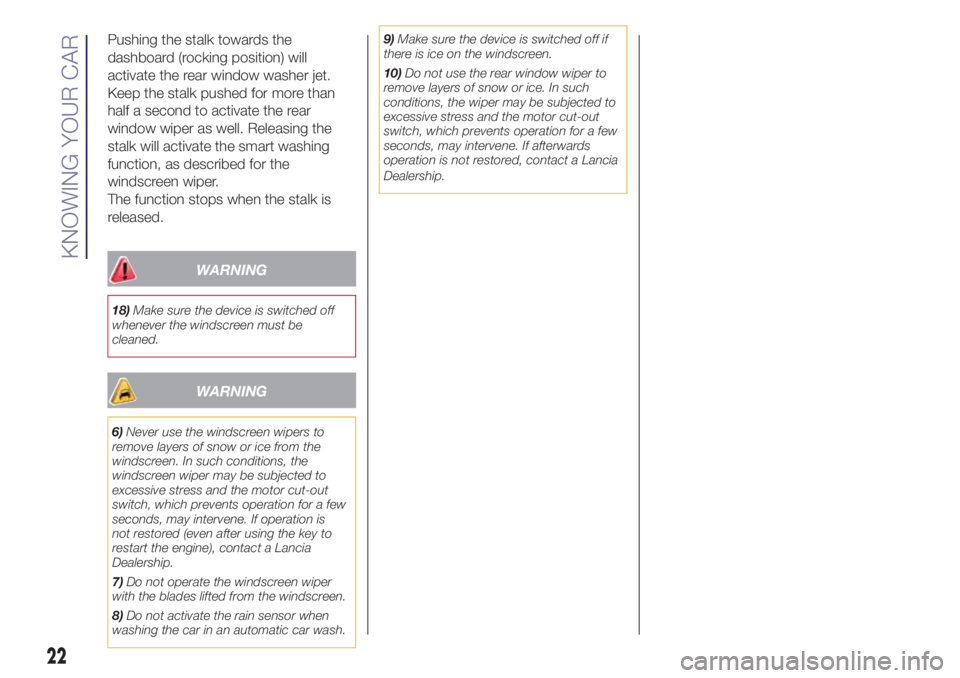
Pushing the stalk towards the
dashboard (rocking position) will
activate the rear window washer jet.
Keep the stalk pushed for more than
half a second to activate the rear
window wiper as well. Releasing the
stalk will activate the smart washing
function, as described for the
windscreen wiper.
The function stops when the stalk is
released.
WARNING
18)Make sure the device is switched off
whenever the windscreen must be
cleaned.
WARNING
6)Never use the windscreen wipers to
remove layers of snow or ice from the
windscreen. In such conditions, the
windscreen wiper may be subjected to
excessive stress and the motor cut-out
switch, which prevents operation for a few
seconds, may intervene. If operation is
not restored (even after using the key to
restart the engine), contact a Lancia
Dealership.
7)Do not operate the windscreen wiper
with the blades lifted from the windscreen.
8)Do not activate the rain sensor when
washing the car in an automatic car wash.9)Make sure the device is switched off if
there is ice on the windscreen.
10)Do not use the rear window wiper to
remove layers of snow or ice. In such
conditions, the wiper may be subjected to
excessive stress and the motor cut-out
switch, which prevents operation for a few
seconds, may intervene. If afterwards
operation is not restored, contact a Lancia
Dealership.
22
KNOWING YOUR CAR
Page 28 of 200
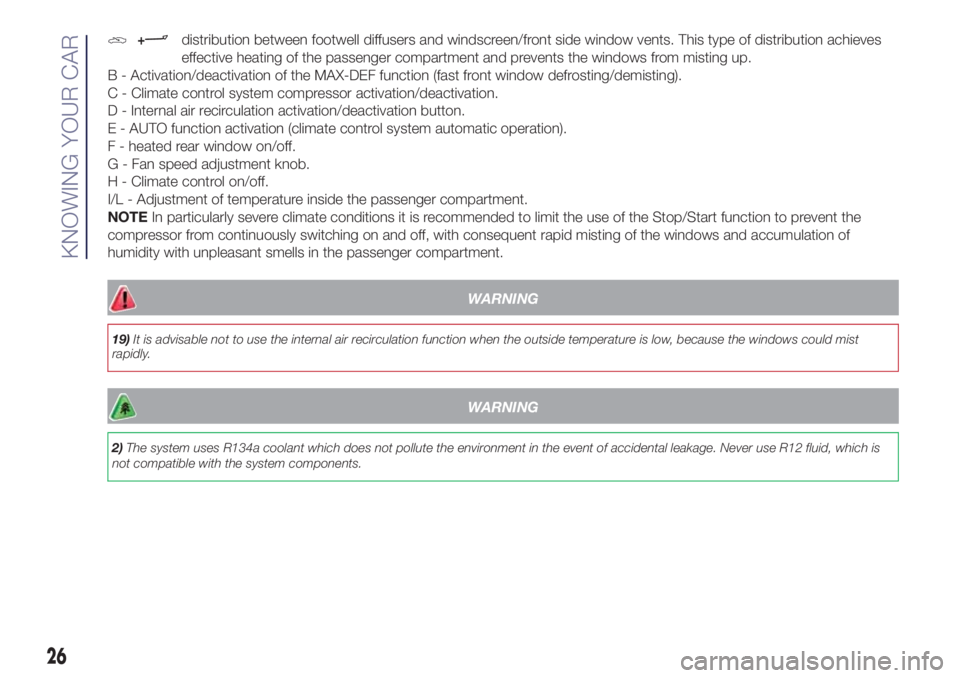
+distribution between footwell diffusers and windscreen/front side window vents. This type of distribution achieves
effective heating of the passenger compartment and prevents the windows from misting up.
B - Activation/deactivation of the MAX-DEF function (fast front window defrosting/demisting).
C - Climate control system compressor activation/deactivation.
D - Internal air recirculation activation/deactivation button.
E - AUTO function activation (climate control system automatic operation).
F - heated rear window on/off.
G - Fan speed adjustment knob.
H - Climate control on/off.
I/L - Adjustment of temperature inside the passenger compartment.
NOTEIn particularly severe climate conditions it is recommended to limit the use of the Stop/Start function to prevent the
compressor from continuously switching on and off, with consequent rapid misting of the windows and accumulation of
humidity with unpleasant smells in the passenger compartment.
WARNING
19)It is advisable not to use the internal air recirculation function when the outside temperature is low, because the windows could mist
rapidly.
WARNING
2)The system uses R134a coolant which does not pollute the environment in the event of accidental leakage. Never use R12 fluid, which is
not compatible with the system components.
26
KNOWING YOUR CAR
Page 29 of 200

ELECTRIC WINDOWS
20)
These operate when the ignition key is
turned to MAR-ON and for about
three minutes after the ignition key is
turned to STOP or removed unless one
of the front doors is opened.
Driver side front door controls
All windows can be controlled from the
driver side door panel fig. 24.
A: front left window opening/closing;
“continuous automatic” operation
during window opening/closing stage;
B: opening/closing front right window;
"continuous automatic" operation
during window opening/closing stage
(for versions/markets, where provided)
C: enabling/disabling of rear door
electric window controls;D: rear left window opening/closing (for
versions/markets where provided);
“continuous automatic” operation
during window opening/closing stage;
E: opening/closing rear right window
(for versions/markets, where provided);
"continuous automatic" operation
during window opening/closing stage.
Use the buttons to open/close the
desired window.
When one of the two buttons is
pressed briefly, the window moves in
stages; if the button is held down,
"continuous automatic" operation is
activated both for closing and opening
(only with ignition key at MAR).
Anti-crush safety device
(for versions/markets, where provided)
11)
This safety system detects the
presence of an obstacle during the
window closing travel and intervenes by
stopping and reversing the window
travel, depending on its position.
The anti-pinch function is active both
during manual and automatic operation
of the electric windows. Following the
intervention of the anti-pinch system,
the window travel is immediately
interrupted and subsequently reversed
until the lower end of travel is reached.
The window cannot be operated in
any way during this time.Electric window system
initialisation
If power supply is interrupted when the
window is moving, the electric window
automatic operation must be
reinitialised.
The initialisation procedure must be
carried out with the doors closed and
for each door, as described below:
fully close the window to be
initialised, with manual operation;
after the window has reached the
upper end of travel, hold the up button
pressed for at least one second.
WARNING
20)Improper use of the electric windows
can be dangerous. Before and during
operation, always check that nobody is
exposed to the risk of being injured either
directly by the moving window or through
objects getting caught or hit by it. When
leaving the vehicle, always remove the
ignition key to avoid the risk of injury for
people still on board due to accidental
operation of the electric windows.
WARNING
11)The system conforms to the
2000/4/EC standard concerning the safety
of passengers leaning out of the passenger
compartment.
24L0F0162C
27
Page 31 of 200
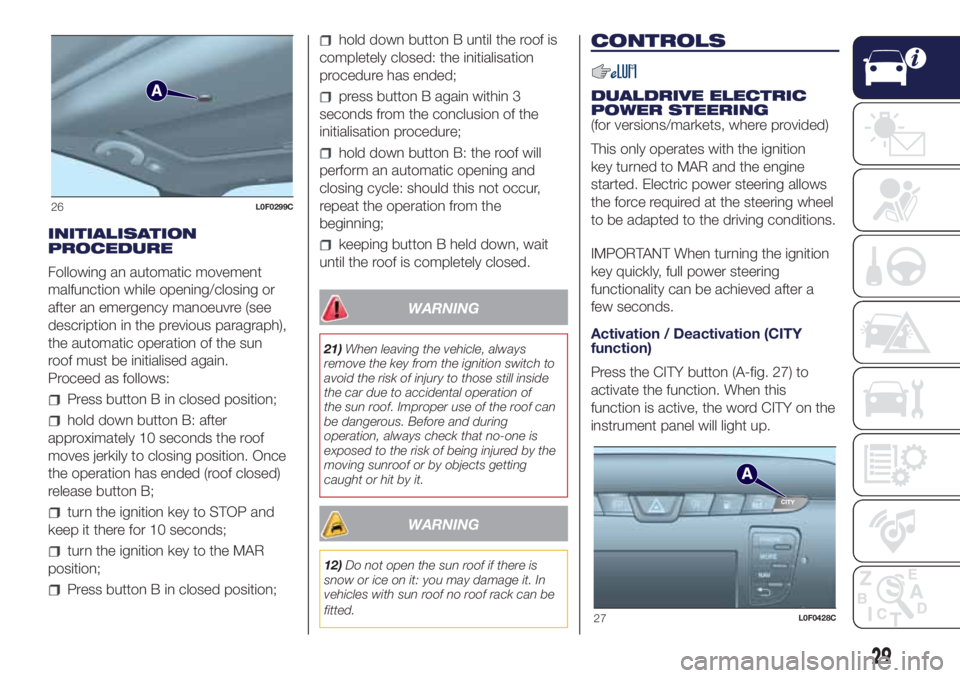
INITIALISATION
PROCEDURE
Following an automatic movement
malfunction while opening/closing or
after an emergency manoeuvre (see
description in the previous paragraph),
the automatic operation of the sun
roof must be initialised again.
Proceed as follows:
Press button B in closed position;
hold down button B: after
approximately 10 seconds the roof
moves jerkily to closing position. Once
the operation has ended (roof closed)
release button B;
turn the ignition key to STOP and
keep it there for 10 seconds;
turn the ignition key to the MAR
position;
Press button B in closed position;
hold down button B until the roof is
completely closed: the initialisation
procedure has ended;
press button B again within 3
seconds from the conclusion of the
initialisation procedure;
hold down button B: the roof will
perform an automatic opening and
closing cycle: should this not occur,
repeat the operation from the
beginning;
keeping button B held down, wait
until the roof is completely closed.
WARNING
21)When leaving the vehicle, always
remove the key from the ignition switch to
avoid the risk of injury to those still inside
the car due to accidental operation of
the sun roof. Improper use of the roof can
be dangerous. Before and during
operation, always check that no-one is
exposed to the risk of being injured by the
moving sunroof or by objects getting
caught or hit by it.
WARNING
12)Do not open the sun roof if there is
snow or ice on it: you may damage it. In
vehicles with sun roof no roof rack can be
fitted.
CONTROLS
DUALDRIVE ELECTRIC
POWER STEERING
(for versions/markets, where provided)
This only operates with the ignition
key turned to MAR and the engine
started. Electric power steering allows
the force required at the steering wheel
to be adapted to the driving conditions.
IMPORTANT When turning the ignition
key quickly, full power steering
functionality can be achieved after a
few seconds.
Activation / Deactivation (CITY
function)
Press the CITY button (A-fig. 27) to
activate the function. When this
function is active, the word CITY on the
instrument panel will light up.
26L0F0299C
27L0F0428C
29
Page 32 of 200
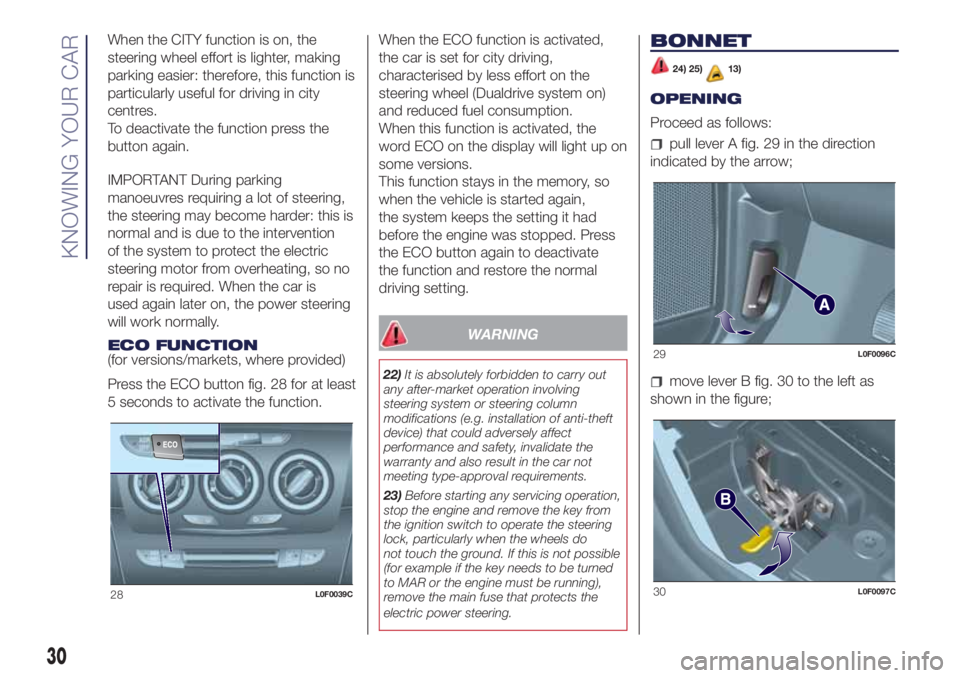
When the CITY function is on, the
steering wheel effort is lighter, making
parking easier: therefore, this function is
particularly useful for driving in city
centres.
To deactivate the function press the
button again.
IMPORTANT During parking
manoeuvres requiring a lot of steering,
the steering may become harder: this is
normal and is due to the intervention
of the system to protect the electric
steering motor from overheating, so no
repair is required. When the car is
used again later on, the power steering
will work normally.
ECO FUNCTION
(for versions/markets, where provided)
Press the ECO button fig. 28 for at least
5 seconds to activate the function.When the ECO function is activated,
the car is set for city driving,
characterised by less effort on the
steering wheel (Dualdrive system on)
and reduced fuel consumption.
When this function is activated, the
word ECO on the display will light up on
some versions.
This function stays in the memory, so
when the vehicle is started again,
the system keeps the setting it had
before the engine was stopped. Press
the ECO button again to deactivate
the function and restore the normal
driving setting.
WARNING
22)It is absolutely forbidden to carry out
any after-market operation involving
steering system or steering column
modifications (e.g. installation of anti-theft
device) that could adversely affect
performance and safety, invalidate the
warranty and also result in the car not
meeting type-approval requirements.
23)Before starting any servicing operation,
stop the engine and remove the key from
the ignition switch to operate the steering
lock, particularly when the wheels do
not touch the ground. If this is not possible
(for example if the key needs to be turned
to MAR or the engine must be running),
remove the main fuse that protects the
electric power steering.
BONNET
24) 25)13)
OPENING
Proceed as follows:
pull lever A fig. 29 in the direction
indicated by the arrow;
move lever B fig. 30 to the left as
shown in the figure;
28L0F0039C
29L0F0096C
30L0F0097C
30
KNOWING YOUR CAR
Page 33 of 200

lift the bonnet and, at the same time,
release the supporting rod C fig. 31
from its catch D, then insert the end of
the rod into housing E in the bonnet
(larger hole) and push to safety position
(smaller hole), as shown in the figure.CLOSING
Proceed as follows:
keep the bonnet raised with one
hand and remove rod C fig. 31 from
housing D with the other, inverting the
opening motion, then fit it back into
its catch;
lower the bonnet to approximately
20 centimetres from the engine
compartment and let it drop. Make sure
that the bonnet is completely closed
and not only fastened by the locking
device by trying to open it. If it is not
perfectly closed, do not try to press the
bonnet lid down but open it and repeat
the procedure.
IMPORTANT Always check that the
bonnet is closed correctly to prevent it
from opening while the vehicle is
travelling.
WARNING
24)The bonnet may drop suddenly if the
supporting rod is not positioned correctly.
25)Perform these operations only when
the car is stationary.
WARNING
13)Use both hands to lift the bonnet.
Before lifting, check that the windscreen
wiper arms are not raised from the
windscreen, that the vehicle is stationary
and that the handbrake is engaged.
31L0F0095C
31